Linking Research and Education
Great Lakes Research and Education Center (GLREC) staff work with educators, partners, and interpretive staff at eleven parks in the National Park Service's Great Lakes Network to bring new research findings to the public. By sharing information through workshops, staff training, research conferences, and bulletins, the GLREC fosters a greater understanding of our natural and cultural resources leading to sound environmental stewardship.
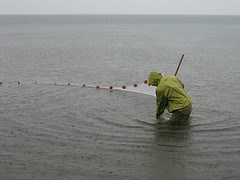
How Do I Learn About Research in National Parks?
All scientists working in national parks are required to submit annual reports on their work. These reports, called "Investigator's Annual Reports", contain short descriptions of the research done in a given year and are online and available to the public.
The Investigator's Annual Report (IAR) is used by the National Park Service to document and track research accomplishments pertaining to natural and cultural resources and social science studies. Annual reports are based on calendar year activities and normally include basic information about research projects including the study title, objectives, and findings.
To view these Investigator's Annual Reports (IARs), visit the Research Permit and Reporting System website. Click "search" in the web page's green band, and select "Investigator's Annual Reports". Then the enter the national park name and reporting year that interest you.
To view a specific report in the list, click on the report title. In some cases, printable PDFs of the report are available.
Upcoming Events and Activities
Volunteers and Citizen Scientists Are Needed!
Citizen science is defined as scientific work undertaken by members of the general public, often in collaboration with or under the direction of professional scientists and scientific institutions. The work accomplished by citizen scientists enables researchers to accomplish tasks that would be too expensive or time consuming to accomplish through other means.Participation in citizen science is a rewarding way to contribute. While adding value, volunteers acquire new learning and skills, and deeper understanding of the scientific work in a fun and engaging way.
The Great Lakes Research and Education Center encourages public participation in citizen science projects dealing with:
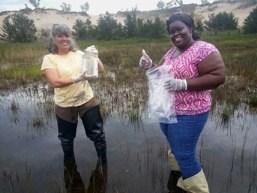
- Impacts of Climate Change on Sugar Maples Join citizen scientists in winter.
- Dragonfly larvae and mercury analysis Citizen Scientists Study Mercury in Dragonfly Larvae
- Monarch butterflies and their habitats Integrated Monarch Monitoring Program
- Water quality Hoosier Riverwatch
- Beach health Adopt-a-BeachTM
If you are interested in participating in citizen science projects within the Great Lakes Research and Education Center network, contact our education coordinator!
Resources for Teachers
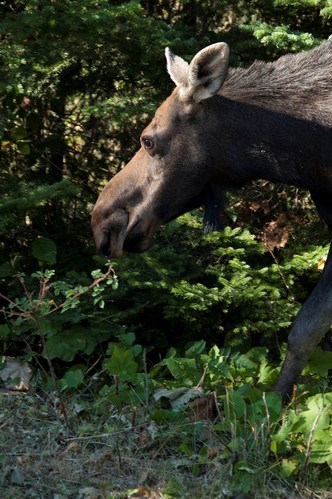
NPS Photo
"Data Nugget" Lessons Feature Research from Apostle Islands and Isle Royale!
Two great new educational activities have recently been developed based on research at Isle Royale National Park and Apostle Islands National Lakeshore! They are “Data Nuggets”. What is a “data nugget”? From the Data Nugget website: “Data Nuggets are free classroom activities, co-designed by scientists and teachers, designed to bring contemporary research and authentic data into the classroom… Each activity gives students practice working with “messy data” and interpreting quantitative information. Students are guided through the entire process of science, including identifying hypotheses and predictions, visualizing and interpreting data, making evidence based claims, and asking their own questions for future research. Because of their simplicity and flexibility, Data Nuggets can be used throughout the school year and across grades K-16, as students grow in their quantitative abilities and gain confidence…”
Check out:
Picky eaters: dissecting poo to examine moose diets
Based on research by Sarah Hoy, John Vucetich and John Henderson from Michigan Technological University on the foraging behavior of moose at Isle Royale National Park.
Candid camera: Capturing the secret lives of carnivores
Based on research on island biogeography and carnivores at Apostle Islands National Lakeshore by Erik Olsen at Northland College, and Tim Van Deelen and Julie Van Stappen from the National Park Service.
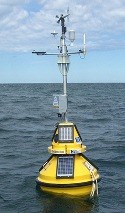
Great Lakes Observing System, photo provided
Teaching with Great Lakes Data
The "Teaching with Great Lakes Data" workshop was cosponsored by Michigan Sea Grant and Indiana Dunes National Lakeshore with support from NOAA. This workshop showed educators how they could teach about climate & weather, storm surges, dead zones, and fish habitat in the Great Lakes and how to use real-time and historical data to teach about these topics. Much data is from "The Great Lakes Observing System" and features near real-time data and archived observations from buoys positioned across the Great Lakes. Data includes lake conditions, water levels, wave heights, air and water temperatures, and more. This data can be utilized in on-line educational activities. To sample activities and data sets used in this workshop, visit the Teaching Great Lakes Science website.
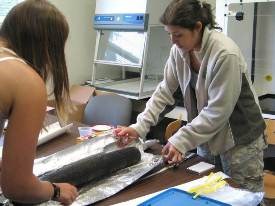
NPS Photo
Local Extinction Dynamics: A 300-Year Experiment
A research study conducted by scientists at Brown University and the University of Wyoming used paleoecological techniques to investigate contemporary extinction dynamics in pond communities in the Miller Woods section of Indiana Dunes National Park. Researchers conducted a detailed study of extinction dynamics following major human disturbances of the mid-late 19th Century by examining plant macrofossils and pollen in well-dated sediment cores. An educational component of the project allowed a local high school teacher to assist and to develop educational lesson plans to compliment the project.
Spreadsheets Across the Curriculum: The Geology of National Parks Collection
Spreadsheets Across the Curriculum was a three-year project developed by Len Vacher, University of South Florida (USF), Tampa, to develop and test educational spreadsheet modules that enhance quantitative literacy wherever quantitative problems arise in the undergraduate curriculum. The project was supported by the National Science Foundation, Division of Undergraduate Education, through award DUE 0442629 (7/2005-6/2008).
Faculty and graduate students in the University of South Florida Geology Department collaborated with eight NPS Research Learning Centers to develop the Geology of National Parks Collection.
The eight partner RLCs (and number of modules) are:
- Appalachian Highlands Science Learning Center (Great Smoky Mountains National Park,2 modules)
- Crown of the Continent Research Learning Center (Glacier National Park, 2 modules)
- Great Lakes Research and Education Center (Indiana Dunes National Park, 2 modules, and Keweenaw National Historic Park, 1 module)
- Greater Yellowstone Science Learning Center (Yellowstone National Park, 4 modules)
- Mammoth Cave International Center for Science and Learning (Mammoth Cave National Park, 2 modules)
- Old-Growth Bottomland Forest Research and Education Center (Congaree National Park, 2 modules)
- Pacific Coast Science and Learning Center (Point Reyes National Seashore, 3 modules)
- Urban Ecology Research Learning Alliance (National Capital Region Parks, 2 modules)
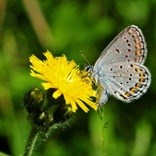
USFWS; Joel Trick
Lesson Plans: Climate Change and the Karner Blue Butterfly
The University of Notre Dame and the United States Geological Survey have partnered with the National Park Service to study the impacts of climate change on the federally endangered Karner blue butterfly. During the summers of 2013 and 2015, high school teacher Jill McNabnay was hired through the University of Notre Dame to participate in a Research Experience for Teachers with funding from the National Science Foundation. Jill worked at Indiana Dunes National Park and in the Hellman Laboratory at the University of Notre Dame assisting with the investigations. Based on these research experiences, work on her masters thesis at Michigan State University, and her previous teaching experience, Jill created a variety of lesson plans which she has made available for interested educators. Featured lessons connecting with the Karner blue research include climate change lessons (grade 9) and endangered species lessons (grade 12). Please e-mail to indicate your interest in viewing these exciting lessons!
Earth to Sky
In "Earth to Sky", interpreters, educators and scientists join in a collegial environment to learn and share science and communication techniques. Much of the science content focuses on climate change. The program fosters the development of interpretive and educational products and programs for use in refuges, parks and other sites of place-based education. The Earth to Sky community of practice is designed to enable participants to connect and collaborate with others through online training and resource sharing.
Network Parks' Educational Resources for Teachers and Students
Visit our network park and park partner Teacher/Education pages.
Recent Events
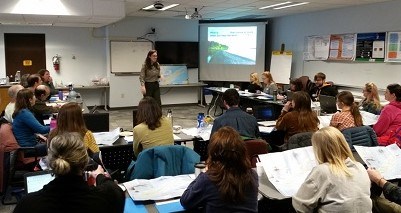
NPS Photo
The Wolves of Isle Royale: An Educator Workshop
In February of 2020, the Great Lakes Research and Education Center partnered with Isle Royale National Park, the Copper County Intermediate School District, and staff from DataNuggets to deliver a professional development workshop focusing on Isle Royal National Park, the island’s ecology, and a wolf translocation project taking place there. Teachers and non-formal educators who work with youth in grades K- 12 discovered how to use the science behind each of these topics to help students understand important principles and to meet state learning standards. Twenty-four teachers, including both formal and non-formal educators and community partners tried their hands at educational activities that can be used in the classroom or informal learning environments and had opportunities to discuss these topics with staff who are directly involved with projects on the island. Educators also had an opportunity to provide input into high quality educational experiences being developed by Isle Royale National Park for students in the future.
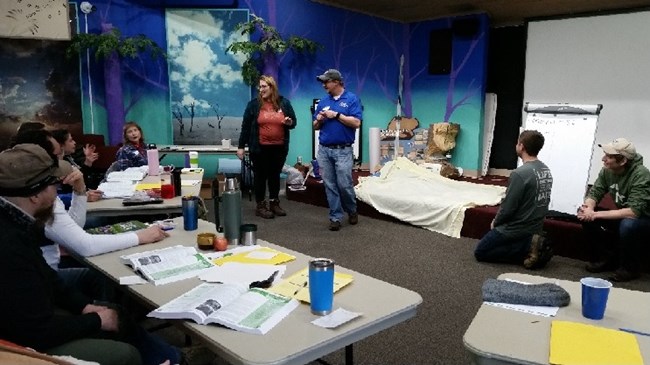
NPS Photo
Project Wild Educator Workshop
In February of 2020, a Project Wild Educator Workshop was held at the Paul H. Douglas Center for Environmental Education at Indiana Dunes National Park. During the workshop, participants tried their hands at a variety of educational activities which they could use to teach their students about wildlife. The activities were from the newly revised Project Wild Curriculum Guide. The guide, published in 2019, is filled with interdisciplinary activities which are hands-on, easy to use (and fun). The new guide includes new and adapted activities as well as field investigations. As a special treat, Dr. Eric Larsen, Associate Professor of Biology at the University of Chicago, was featured as a guest presenter and shared about a project to census small mammal populations, an activity which ties in nicely with the field investigations section of the guide. Eleven people, including both formal and non-formal educators, enjoyed both indoor and outdoor activities during the day.
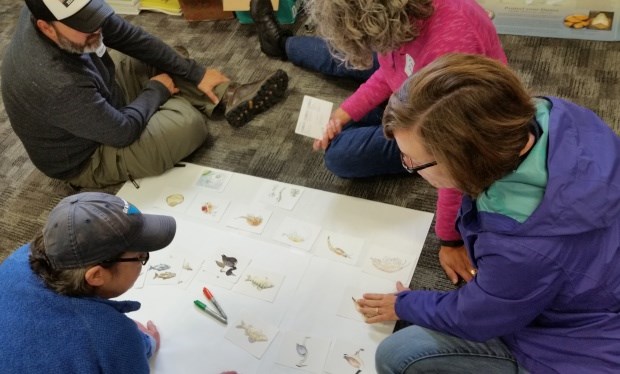
NPS photo
Great Lakes in My World Educator Workshop
at Sleeping Bear Dunes National Lakeshore
In September of 2018, educators working with youth in grades 3 – 12 spent the day immersed in educational activities that explore the Great Lakes and Great Lakes issues. This workshop was held in Sleeping Bear Dunes National Lakeshore, near Empire, Michigan. Participants received a copy of the Alliance for the Great Lakes’ Great Lakes in My World Curriculum Guide to take home. The K-8 Guide features activities covering lakes, sand dunes, wetlands, human communities, history and geology – all as they relate to our Great Lakes! The guide for grades 9 – 12 focuses on coastal habitats, restoration, careers and stewardship. The event was co-sponsored by Sleeping Bear Dunes National Lakeshore , the Great Lakes Research and Education Center, and the Alliance for the Great Lakes. Funding was provided by the Great Lakes Restoration Initiative.
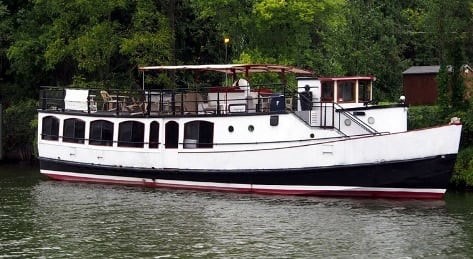
Photo by Harbor Country Adventures
Educators’ Back to School Boat Ride
In September of 2018, educators’ working with students in grades K- 12 were invited to enjoy a FREE morning on Lake Michigan! The plan was to come aboard the Emita II in Michigan City, IN, and enjoy the beauty of Lake Michigan and views of our amazing Indiana Dunes from a cruise along the Indiana shoreline. Unfortunately the weather didn't cooperate and the boat was unable to go out. Instead of a boat ride, participants met at Mount Baldy in Indiana Dunes National Park and learned about educational activities they can use to help their students learn about our Great Lakes. They also spoke first hand with researchers and learned about Great Lakes focused research projects USGS scientists are currently conducting beneath the lake’s waters!
Each participant received a Great Lakes in My World Curriculum Guide developed by the Alliance for the Great Lakes. This event was co-sponsored by Indiana Dunes National Lakeshore, the Great Lakes Research and Education Center, Dunes Learning Center, and the Alliance for the Great Lakes. Funding was provided by the Great Lakes Restoration Initiative. .
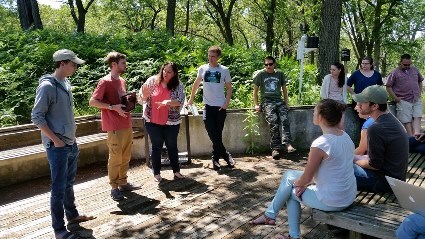
NPS photo
iSWOOP in Action at Indiana Dunes National Lakeshore
iSWOOP stands for "Interpreters and Scientists Working on Our Parks". In June of 2018, the iSWOOP team arrived in Northwest Indiana and helped interpreters and resource managers at Indiana Dunes National Park learn about research being conducted by Dr. Robert Brodman and also by Dr. Erin Argyilan and Dr. Todd Thompson. Brodman's research focuses on the impacts of climate change on amphibians in the park. That of Argyilan and Thompson look into phenomena related to changes through time at the Mount Baldy sand dune. Participating interpreters learn techniques to communicate effectively with the public about these projects. Now interpreters are sharing about this research in a variety of ways. iSWOOP focuses on different research projects in different national parks. Learn more about iSWOOP.
Links to Additional Resources
Government Agency Education Websites
- NASA Education
- NOAA Education Resources
- US Fish and Wildlife Service Educational Resources
- USGS Education Resources
Science Education Standards
Last updated: September 30, 2021
